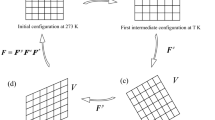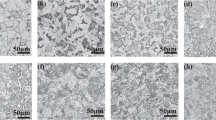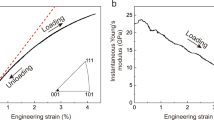Abstract
THE presence of a transition in the electrical resistivity and temperature coefficient of resistance of chromium in the region of 40° C. has been reported by several investigators1. In studying the influence of plastic deformation (at 150° C.) on high-purity chromium an anomaly has been found, in that below the transition temperature the deformed material had a lower resistivity than the annealed. Curves of resistivity versus temperature are shown in Fig. 1, together with the respective temperature coefficients of resistance. No hysteresis was observed in these measurements. A positive deviation in the temperature coefficient of resistance of the deformed material is observed both below and above the transition temperature. A minimum in the curve of resistivity versus temperature for the annealed material (Fig. 1) occurs at 41° C. and is in close agreement with other workers. Particulars of the specimen material are recorded in Table 1. As shown in Fig. 2, a change in the sign occurs, from negative to positive, in the value of Δρ (the difference in resistivity between the deformed and the annealed material) on increasing temperature through the transition region, namely, −40° C. to + 40° C.
This is a preview of subscription content, access via your institution
Access options
Subscribe to this journal
Receive 51 print issues and online access
$199.00 per year
only $3.90 per issue
Buy this article
- Purchase on Springer Link
- Instant access to full article PDF
Prices may be subject to local taxes which are calculated during checkout
Similar content being viewed by others
References
Bridgman, P. W., Proc. Amer. Acad. Arts Sci., 68, 27 (1933). Potter, H. H., Proc. Phys. Soc., 53, 695 (1941). Fine, M. E., Greiner, E. S., and Ellis, W. C., J. Metals, 191, 56 (1951). Sully, A. H., Brandes, E. A., and Mitchell, K. W., J. Inst. Met., 81, 585 (1953).
Sully, A. H., “Chromium”, 63 (Butterworths, London, 1954).
McGuire, T. R., and Kriessman, C. J., Phys. Rev., 85, 452 (1952).
Powell, R. W., and Tye, R. P., J. Inst. Met., 85, 185 (1957).
Thomas, J. L., J. Res. Nat. Bur. Stand., 13, 681 (1934).
Linde, J. O., App. Sci. Res., Hague, B, 4, 73 (1954).
Linde, J. O., Ark. Mat. Astro. Fys., A, 36, Paper No. 10 (1948).
Kronqvist, E., Ark. Mat. Astro. Fys., B, 34, Paper No. 7 (1947).
Lingelbach, R., Z. Phys. Chem., 5, 273 (1955).
Shull, C. G., and Wilkinson, M. K., Rev. Mod. Phys., 25, 100 (1953).
Author information
Authors and Affiliations
Rights and permissions
About this article
Cite this article
DE MORTON, M. Effect of Plastic Deformation on the Electrical Resistivity of Chromium. Nature 181, 477–478 (1958). https://doi.org/10.1038/181477c0
Issue Date:
DOI: https://doi.org/10.1038/181477c0
Comments
By submitting a comment you agree to abide by our Terms and Community Guidelines. If you find something abusive or that does not comply with our terms or guidelines please flag it as inappropriate.



